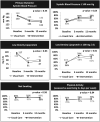Efficacy of a Chronic Care-Based Intervention on Secondary Stroke Prevention Among Vulnerable Stroke Survivors: A Randomized Controlled Trial
- PMID: 29321134
- PMCID: PMC5769158
- DOI: 10.1161/CIRCOUTCOMES.116.003228
Efficacy of a Chronic Care-Based Intervention on Secondary Stroke Prevention Among Vulnerable Stroke Survivors: A Randomized Controlled Trial
Abstract
Background: Disparities of care among stroke survivors are well documented. Effective interventions to improve recurrent stroke preventative care in vulnerable populations are lacking.
Methods and results: In a randomized controlled trial, we tested the efficacy of components of a chronic care model-based intervention versus usual care among 404 subjects having an ischemic stroke or transient ischemic attack within 90 days of enrollment and receiving care within the Los Angeles public healthcare system. Subjects had baseline systolic blood pressure (SBP) ≥120 mm Hg. The intervention included a nurse practitioner/physician assistant care manager, group clinics, self-management support, report cards, decision support, and ongoing care coordination. Outcomes were collected at 3, 8, and 12 months, analyzed as intention-to-treat, and used repeated-measures mixed-effects models. Change in SBP was the primary outcome. Low-density lipoprotein reduction, antithrombotic medication use, smoking cessation, and physical activity were secondary outcomes. Average age was 57 years; 18% were of black race; 69% were of Hispanic ethnicity. Mean baseline SBP was 150 mm Hg in both arms. SBP decreased to 17 mm Hg in the intervention arm and 14 mm Hg in the usual care arm; the between-arm difference was not significant (-3.6 mm Hg; 95% confidence interval, -9.2 to 2.2). Among secondary outcomes, the only significant difference was that persons in the intervention arm were more likely to lower their low-density lipoprotein <100 md/dL (2.0 odds ratio; 95% confidence interval, 1.1-3.5).
Conclusions: This intervention did not improve SBP control beyond that attained in usual care among vulnerable stroke survivors. A community-centered component could strengthen the intervention impact.
Clinical trial registration: URL: https://clinicaltrials.gov. Unique identifier: NCT00861081.
Keywords: blood pressure; exercise; risk factors; secondary prevention; stroke.
© 2017 American Heart Association, Inc.
Figures




Comment in
-
Importance and Challenges of Moving Stroke Prevention into the Community.Circ Cardiovasc Qual Outcomes. 2018 Jan;11(1):e004513. doi: 10.1161/CIRCOUTCOMES.117.004513. Circ Cardiovasc Qual Outcomes. 2018. PMID: 29321136 No abstract available.
References
-
- Mozaffarian D, Benjamin EJ, Go AS, Arnett DK, Blaha MJ, Cushman M, Das SR, de Ferranti S, Despres JP, Fullerton HJ, Howard VJ, Huffman MD, Isasi CR, Jimenez MC, Judd SE, Kissela BM, Lichtman JH, Lisabeth LD, Liu S, Mackey RH, Magid DJ, McGuire DK, Mohler ER, 3rd, Moy CS, Muntner P, Mussolino ME, Nasir K, Neumar RW, Nichol G, Palaniappan L, Pandey DK, Reeves MJ, Rodriguez CJ, Rosamond W, Sorlie PD, Stein J, Towfighi A, Turan TN, Virani SS, Woo D, Yeh RW, Turner MB on behalf of the American Heart Association Statistics Committee and Stroke Statistics Subcommittee. Heart Disease and Stroke Statistics-2016 Update: A Report From the American Heart Association. Circulation. 2016;133:e38–e360. - PubMed
-
- Sacco RL, Adams R, Albers G, Alberts MJ, Benavente O, Furie K, Goldstein LB, Gorelick P, Halperin J, Harbaugh R, Johnston SC, Katzan I, Kelly-Hayes M, Kenton EJ, Marks M, Schwamm LH, Tomsick T. Guidelines for prevention of stroke in patients with ischemic stroke or transient ischemic attack: a statement for healthcare professionals from the American Heart Association/American Stroke Association Council on Stroke: co-sponsored by the Council on Cardiovascular Radiology and Intervention: the American Academy of Neurology affirms the value of this guideline. Circulation. 2006;113:e409–449. - PubMed
-
- Lager KE, Mistri AK, Khunti K, Haunton VJ, Sett AK, Wilson AD. Interventions for improving modifiable risk factor control in the secondary prevention of stroke. Cochrane Database Syst Rev. 2014;5:CD009103. - PubMed
-
- Stansbury JP, Jia H, Williams LS, Vogel WB, Duncan PW. Ethnic disparities in stroke: Epidemiology, acute care, and postacute outcomes. Stroke. 2005;36:374–386. - PubMed
Publication types
MeSH terms
Associated data
Grants and funding
LinkOut - more resources
Full Text Sources
Other Literature Sources
Medical

